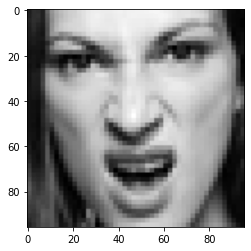Package allows visualize convolutional layers from keras models.
This package is a set of tools for visualizing convolutional layers from keras models. At this moment includes:
- Keras - version 2.4.3
- Matplotlib - version 3.3.3
- NumPy - version 1.19.4
- OpenCV - version 4.4.0.46
- TensorFlow - version 2.4.0rc1
- Install from PyPi:
pip install keras-conv-visualizer
import matplotlib.pyplot as plt
from tensorflow.keras.applications import VGG16
from keras_conv_visualizer.filters import FilterVisualization
# Model has to have standarized input (std=0, var=1)!
model = VGG16(weights="imagenet", include_top=False, input_shape=(224, 224, 3))
layer_name = "block5_conv3"
# First parameter - trained keras model, second - input_size
fv = FilterVisualization(model)
# First parameter - layer feature index (ex. block1_conv1 has (224, 224, 64) index is from 0 to 63)
# Second parameter - layer name
loss, img = fv.visualize_filter(0, layer_name)
plt.imshow(img)Result:
from tensorflow.keras.preprocessing.image import load_img, img_to_array
from tensorflow.keras.applications import VGG16, imagenet_utils
import matplotlib.pyplot as plt
from keras_conv_visualizer.gradcam import GradCAM
img_path = 'elephant.jpg'
# load the input image from disk (in Keras/TensorFlow format) and preprocess it
image = load_img(img_path, target_size=(224, 224))
image = img_to_array(image)
image = imagenet_utils.preprocess_input(image)
model = VGG16(weights="imagenet", input_shape=(224, 224, 3))
cam = GradCAM(model)
# First parameter - image tensor, second - image path, third - alpha value for heatmap (transparency)
heatmap, output = cam.make_superimposed_img(image, img_path, alpha=0.6)
plt.imshow(heatmap)
plt.imshow(output)Results:
 |
 |
 |
|---|---|---|
| Input image | Heatmap | Superimposed image |
from keras.models import load_model
from keras.preprocessing import image
from keras_conv_visualization.intermediate_activations import IntermediateActivations
# load the input image from disk (in Keras/TensorFlow format) and preprocess it
img = image.load_img('some_image.png', target_size=(96, 96), color_mode='grayscale')
img_tensor = image.img_to_array(img)
img_tensor /= 255
model = load_model('some_model.h5')
int_activations = IntermediateActivations(model)
int_activations.plot_intermediate_activations(img_tensor)Input image:
Results:
- Add shap values
- Automatically recognition input size for FilterVisualization
Want to contribute? Great!
To fix a bug or enhance an existing module, follow these steps:
- Fork the repo
- Create a new branch (
git checkout -b improve-feature) - Make the appropriate changes in the files
- Verify if they are correct
- Add changes to reflect the changes made
- Commit changes
- Push to the branch (
git push origin improve-feature) - Create a Pull Request
Library is: in progress
albert.lis.1996@gmail.com - feel free to contact me!





